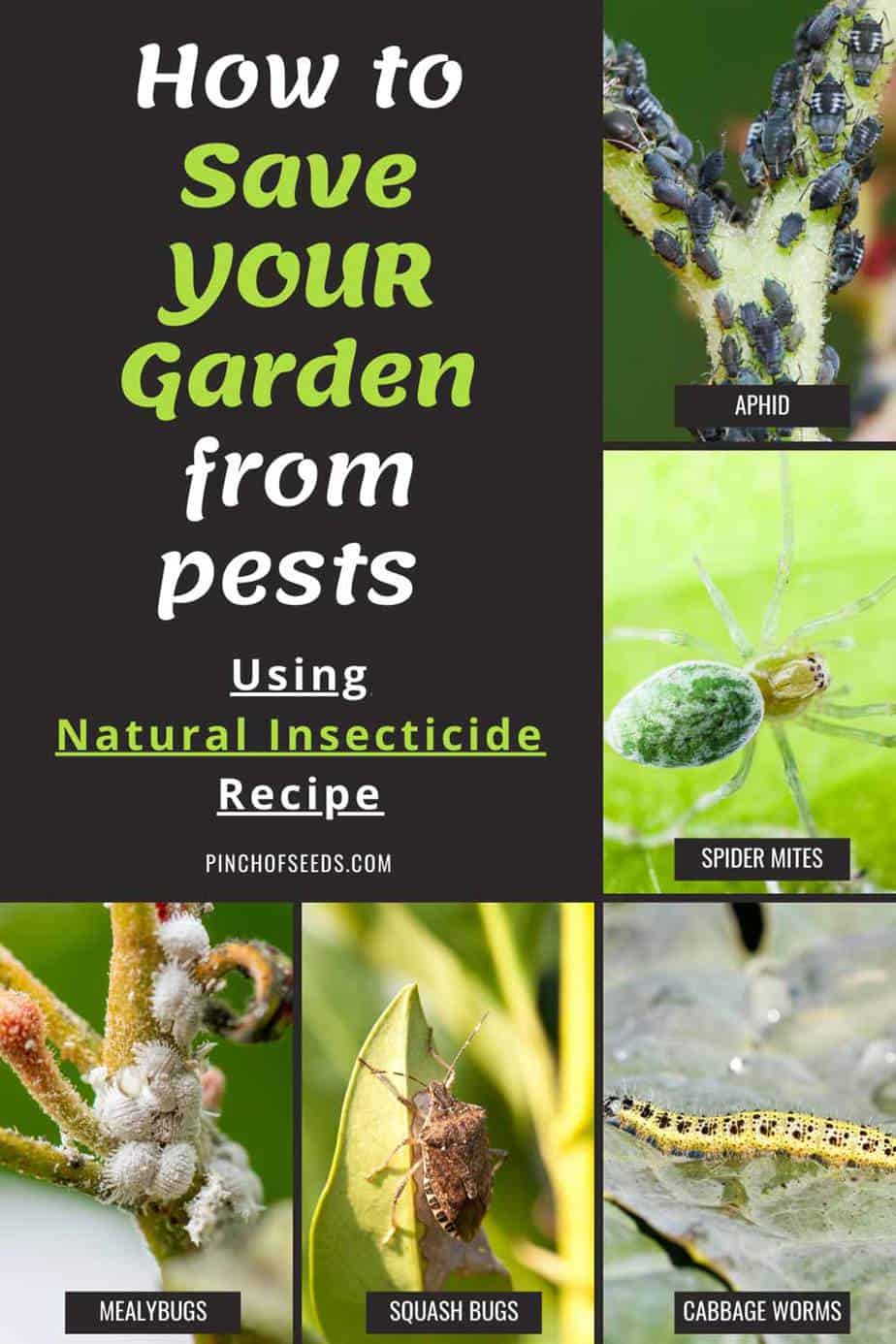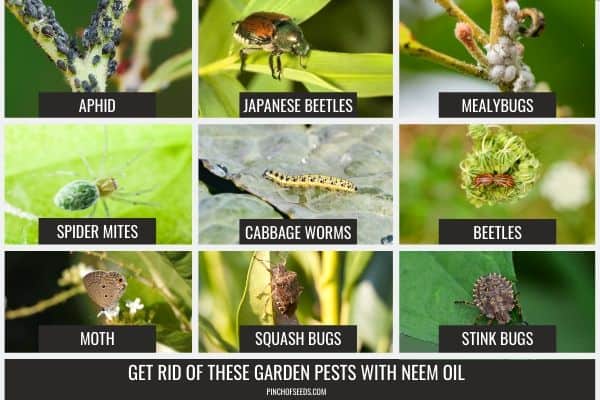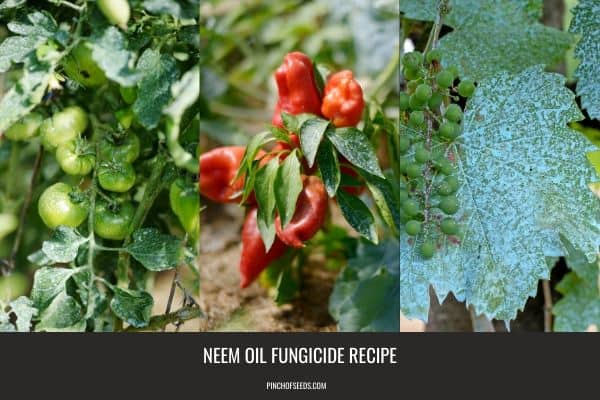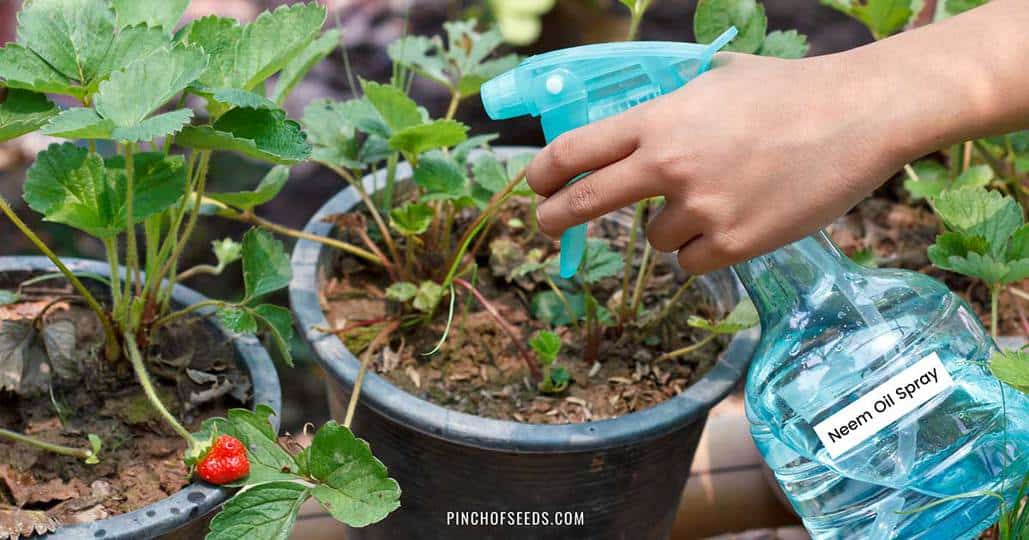Share this with your friends:

Neem oil is a natural, plant-based extract that has been used in India and other parts of Asia for centuries. Neem oil is made from the seeds of the neem tree and has a wide range of benefits and uses for beauty, wellness, and gardening.
You may know that Neem oil is an extraordinary organic and natural component for home vegetable gardens and houseplants. However, do you know how to mix neem oil for plants to make Neem oil sprays and treatments?
Neem oil is safe to use on most plants and houseplants, including vegetables, fruits, herbs, and ornamentals. To kill aphids on roses, neem oil is an excellent and effective option. This is the only pesticide I use in my organic home vegetable garden and on my curry plants.
Why use Neem oil for houseplants and garden?
Neem oil can be used as an insecticide to get rid of bugs on plants, as a fungicide to control bacterial and fungal diseases on plants, and as a soil drench liquid to get rid of spores and larva in the soil. Neem oil extract effectively eliminates a wide range of pests, including aphids, whiteflies, leafhoppers, mites, thrips, and scale insects. Neem oil also helps control black spots, powdery mildew, and rust on plants.
Let me explain how Neem oil works on insects and fungus and how to mix Neem Oil for plants for pest control and disease prevention:
1. How to use Neem oil to get rid of bugs on plants:
Insects can be a huge nuisance in the garden, eating away your plants, fruits, and buds and leaving behind unsightly damage.
Not only can insects and pests be a major annoyance, but they can also cause significant damage to plants and may even kill them. If left untreated, an insect infestation can quickly get out of control and may even destroy your entire garden.
Insects can harm plants and gardens is by eating the leaves of the plants. Losing the leaves make it more difficult for the plant to photosynthesize, which is how the plant makes its food.
Insects travel from one plant to another. Thus spreading diseases to plants, killing them, or making it more challenging for them to grow optimally.
Additionally, some insects lay their eggs on plants. When the eggs hatch, the larvae feed on the tender parts of the plant. This can cause extensive damage to the plant tissue and make it more difficult to recover.
Finally, some insects simply suck the juice out of plants, weakening the plant systems and making the plant more susceptible to other diseases and insect damage.
What is Insecticide?
An insecticide is a pesticide that is used to kill or control insects. Insecticides are available in various formulations, including dust, aerosols, liquids, granules, and baits. Some insecticides are biological control agents, which are derived from other organisms that naturally prey on or parasitize the target insects. Others are synthetic chemical compounds that have been specifically designed to kill insects. Insecticides can be used to control pests indoors and outdoors and on crops, gardens, lawns, and houseplants.
What is an Organic Insecticide?
Organic Insecticide is a type of pesticide that is made from natural ingredients. These pesticides effectively control a wide variety of pests, and they are also safe for humans and the environment. There are several different types of organic insecticides available on the market. Each one has its own advantages and disadvantages. Therefore, when choosing an organic insecticide, it is essential to consider the specific needs of your garden or home.

Why use Neem Oil on plants as Insecticide?
Neem seeds contain a substance called ‘Azadirachtin.’ Different insects react to Azadirachtin differently. After coming in contact with Azadirachtin, some insects lose the instinct to feed and cannot eat. At the same time, some cannot lay eggs or reproduce. They cannot survive and grow in both ways, thus gradually reducing the infestation.
What bugs does Neem Oil kill?
The ‘Azadirachtin’ found in neem oil has been known to kill Spider mites, Aphids, Whiteflies, Cabbage worms, Mealybugs, Fungus Gnats, Moths, Nematodes, Scales, Flea Beetles, Squash bugs, Stink Bugs, and Caterpillars. It is also helpful in controlling Japanese beetles, Mosquitoes, Grubs, Slugs, Snails, and Crickets.
It’s believed that more than 400 bug species don’t like neem oil. So if you have an insect problem in your garden that isn’t on the list above, it won’t hurt to try the neem oil spray on them to find out!
What you need for making Neem oil spray for plants:
#1 A good quality Neem Oil:
I choose to buy Organic, cold press, 100% pure Neem oil, because it can be used not only in making a plant sprays, but also be used for cosmetic purposes and in household remedies.
Here are my recommendations for the best Neem oil to use in your garden:
Best Neem Oil For Plants
My Choice #
1
2
#2 Dish Soap or Castile Soap:
Neem oil does not dissolve in the water by itself. When added alone, it will float on the water surface. It is essential to understand how to emulsify neem oil into water using an emulsifier (dish soap or Castile soap) that bonds with neem oil droplets, and distributes the molecules in the water evenly.
If using dish soap, use a mild or natural dish soap.
I prefer to use Castile soap, which is a natural product and reduces the risk of plant burn.
Here are some of the Castile soaps I have used with great success for insect control:
Best Castile Soap For Plants
My Choice #
1
2
#3 Garden Sprayer:
If spraying the entire yard or large garden bed, I highly recommend investing in a good quality sprayer.
Recipe: How to mix Neem Oil for plants to get rid of bugs
Using a few common household ingredients, you can easily make your own homemade substitute for store brand neem oil insecticide plant spray. Pay attention to the Neem oil ratio as well as how to dilute neem oil for plants. This neem oil dilution is effective in controlling crawling and chewing insects on plants.
Ingredients:
To make 1 Quart Neem Oil Insecticide spray, you will need:
- 1 teaspoon Neem oil (100% Cold Press Neem Oil)
- 0.25 teaspoon liquid dish soap (Castile soap is preferred)
- 1 qt Warm Water
- Spray Bottle
- Measuring spoons or Dropper
To make 1 Gallon Neem Oil Insecticide spray, you will need:
- 4 teaspoons Neem oil (100% Cold Press Neem Oil)
- 1 teaspoon liquid dish soap (Castile soap is preferred)
- 1 Gallon Warm Water
- Garden Sprayer
- Measuring spoons
Process:
Step 1: Fill a spray bottle with warm water.
Step 2: Add Liquid dish soap to the spray bottle. Gently stir to mix the soap.
Step 3: Add neem Oil to the mixture.
Step 4: Close the bottle and shake the mixture until oil is well combined with the soap mixture.
Step 5: Spray the mixture on the top and bottom of the leaves, shaking the bottle frequently between the sprays.
When and how to apply Neem oil mixture on plants
Does your squash or eggplant have holes on the leaves? Do you see small insects crawling on the tomato plants in garden? Or are you annoyed by the fungus gnats flying over the seedlings that you started indoors? If you answered ‘Yes’ to any of the questions or to control any pests that damage your vegetable garden, you need to use neem Oil spray on the infested plants.
Tips for applying the Neem Oil insecticide in your garden:
- Some bugs hide the underside of the leaves. Thoroughly wet both sides of leaves with the spray.
- Neem oil spray should be applied in the morning or evening. Avoid spraying the plants in the afternoon hours and when the temperature is above 80F.
- Oil should have a chance to come in contact with the insect to be able to kill them. Avoid spraying when the rain is expected shortly.
- Don’t store the neem oil mixture as its effectiveness will reduce after 40 minutes of mixing with the water and soap. Discard the remaining oil spray mixture when done spraying.
- Don’t forget to clean the spray bottle or sprayer before storing it. The neem oil residue can clog up the nozzle when dried.
- Start with the above recipe. If there is no improvement after a couple of applications, increase neem oil amount to 1.5 times.
- As a pesticide: To control an infestation, apply the neem Oil spray every 7 days until the bugs are gone. Remember, neem oil is an organic, natural product. It takes time to completely get rid of the bugs. Be patient and continue application every 7 days. Consistency is the key here!
- As a preventative spray: To prevent attacks from pests on your plants, be proactive in applying the neem oil spray. Soak the plants with neem oil spray at every 14 days interval. Avoid the high-temperature days of summer.
Neem oil’s key ingredient, ‘Azadirachtin’, is an excellent insect repellent, but does it work on controlling fungus?
2. How to use Neem oil on plants to control plant diseases:
Not only insects but diseases can also damage a garden. Typical disease symptoms in plants include yellowing or wilting leaves, spots or lesions, stunted growth, and premature death. Many plant diseases are caused by fungi, which can be challenging to control. Bacterial and viral infections are also common. Prevention is key to keeping your plants healthy, as treatment can be complex once a plant is infected. Regular inspection of your plants, prompt removal of diseased specimens, and good sanitation practices will help to keep your garden free of disease.
Is Neem oil a fungicide?
Yes, Neem oil has excellent anti-fungal characteristics. It can help control many fungal problems in the garden, including powdery mildew, blight, rust, Scab, and black spots. When applied as a preventative measure before the plant is infected, neem oil can protect the plant from the fungal diseases for the entire season.

Recipe: How to mix Neem Oil for plants to control diseases
Here’s the Neem oil recipes to make an effective homemade Fungicide for tomatoes, cucumbers, squash and other vegetables:
Ingredients:
- 1 Gallon Water
- 1 teaspoon Rosemary oil
- 1 teaspoon Peppermint oil
- 2 tablespoons Neem oil (100% Cold Press Neem Oil)
- 2 tablespoons Olive oil or almond oil
- Garden Sprayer
- Measuring Spoon
Process:
Step 1: Fill a garden sprayer with warm water.
Step 2: Add liquid dish soap to the sprayer. Gently stir to mix the soap.
Step 3: Measure and add rosemary oil, peppermint oil, neem oil, and olive oils to the mixture.
Step 4: Close the bottle and shake the mixture until oil is well combined.
Step 5: Spray the mixture on the top and bottom of the leaves, shaking the bottle frequently between the sprays.
When and How to Apply Neem Oil spray on Plants
Here are some pointers for applying neem oil on your garden as a fungicide:
- Apply on a mild, cloudy day to avoid burning the leaves.
- Don’t use the spray if rain is predicted soon.
- Spray both sides of the leaves for total coverage.
- To manage an existing condition: Promptly remove heavily infected leaves from the plant and discard them in the garbage. To control a fungal infection, apply the neem Oil spray every 7 days until the color of the leaves changes back to normal.
- As a preventative spray: To prevent fungal problems like black spots, powdery mildew, and rust, soak the plants with neem oil spray at every 14 days interval. Avoid the days when the temperature is predicted to go beyond 80F.
3. How to apply Neem oil to soil to kill spores and larva:
Can Neem oil be used as a soil drench?
Yes, Neem oil is a systemic pesticide that works effectively in controlling sucking or piercing bugs when used as a soil drench. When diluted Neem oil is poured at the base of the plant, Neem oil is sucked up by the plant roots and enters into the plant’s vascular system. If any sucking or piercing insects like an aphid, mealybug, or squash bug bites into the plant’s tissue or leaves, Azadirachtin enters the bug’s body. It reacts to the bug’s feeding, reproductive and growth hormones, eventually killing the insect.
Recipe: How to use Neem oil to kill spores and larva in soil
For neem oil soil drench, you need the same ingredients as the insecticide spray recipe but in the larger quantity.
Ingredients:
To make 1 Gallon Neem Oil Soil Drench, you will need:
- 2 tablespoons Neem oil (100% Cold Press)
- 1 teaspoon liquid dish soap (Castile soap is preferred)
- 1 Gallon Warm Water
- Bucket
- Measuring spoons
- Wooden stirrer
Process:
Step 1: Add dish soap to the gallon of warm water in the bucket. Stir to dissolve and distribute the soap.
Step 2: Pour in the neem oil into the soapy water. Mix thoroughly.
Step 3: Depending upon the size of the plant, pour 2 to 3 cups of this mixture at the base of the plant. If using for a shrub or tree, pour more quantity.
Step 4: Do not water the same day of the application. Water normally starting the next day.
Step 5: As a preventative remedy, repeat the application every 2 to 3 weeks.
4. How to use Neem oil on houseplants:
There are a few things to keep in mind when using Neem oil on houseplants and other indoor plants. This tips also applies to the seedlings started indoors.
- Always read the recipes and mix Neem oil with water carefully.
- It is best to take the indoor plant outside on a non-windy day to apply neem oil on the houseplant. If sprayed indoors, the Neem oil mixture may stain the wall and flooring.
- Be sure to apply the Neem oil mixture evenly over the entire plant, including the undersides of the leaves and stems.
- Avoid using Neem oil spray on delicate houseplants like Orchid, as this can damage the plant.
- After applying the Neem oil spray, make sure to wash your hands thoroughly.
- If you have any leftover neem oil mixture, be sure to dispose of it properly. Don’t store it. It is always best to prepare the Neem oil spray right before the application.
Tips For Handling Neem Oil Concentrate:
There are some things you need to be aware of when using neem oil in your garden:
- Treat neem oil like you would commercial products. Neem oil has some potent components, so you want to carefully handle the spray bottle. Avoid getting it in your eyes or ingesting it.
- Watch the weather: Plan your neem oil application for another day if there’s any wet weather in the forecast. The water will wash away the oil, and your plant won’t get the full benefit of the spray.
- Keep the bottle somewhere secure: When combined with water and soap, neem oil will start breaking down after an hour. So, it is advisable to mix the amount as much as you can use during one application. If you have to store the spray, tightly screw on the top of your neem oil insecticide/fungicide bottle. Put it in a dry, room temperature environment away from kids and pets.
- You may choose to add a few drops of neem oil while making insecticidal soap.
Related Questions
Is Neem oil safe to use in the garden?
Your garden doesn’t only have plants, but other wildlife, too. What about the bees, birds, and butterflies in your garden? Will they be okay if you spray Neem oil all over the garden?
Yes, they will! These animals and creatures aren’t affected by neem oil, as to them, it’s non-toxic. The oil will just keep out the bugs you don’t want but let all the other cool wildlife in. What a win-win!
Is Neem oil safe to use for humans?
Yes, Neem oil is a natural product mostly made of fatty acids and glycerides. In general, it is safe for humans. But if ingested, it can cause vomiting, upset stomach, or drowsiness. It could cause slight irritation to the eyes and skin as well.
How much neem oil is needed per gallon?
For effective insecticide solution, you may use 4 tablespoon Neem oil per gallon of water. Make sure to add the other ingredients in the order it is described above.
Can I use Neem oil for Mealy bugs?
Yes, you can use neem oil spray on mealybugs. Mealybugs are common pests of indoor and outdoor plants. They feed on plant sap, which can cause yellowing or stunted growth in plants. Neem oil is a natural, organic way to control mealybugs. It works by disrupting the mealybugs’ life cycle and preventing them from reproducing. Spray the neem oil spray on infested plants, being sure to cover all of the affected areas. Repeat this treatment every 7-10 days until the mealybugs are gone.
Does neem oil kill spiders?
Yes, neem oil can kill spiders. Neem oil is a natural insecticide that is effective against a wide variety of pests, including spiders. When applied to the affected area, neem oil spray will kill the spider within minutes.
Will Neem oil hurt beneficial insects?
No, Neem oil does not hurt most of the beneficial insects like Ladybugs, Butterflies, and bees. Neem oil kills or respells soft-bodied bugs and the insects that chew on the plant bodies. Most of the beneficial insects don’t bite the plants, so they are not affected, but the larvae of these beneficial insects might be smothered by the Neem oil sprays.
Insecticidal soap vs neem oil: what’s the difference?
Insecticidal soap is made of potassium salts of fatty acids and is effective against most soft-bodied insects, including aphids, whiteflies, and spider mites. Neem oil is a vegetable oil pressed from the fruit and seeds of the neem tree and is effective against a wide range of insects, including caterpillars, beetles, mites, and scale. Both products are relatively safe to use around people and pets when used according to label directions.
Conclusion
Neem oil is a handy, natural ingredient for homemade organic insecticides and fungicides. Both can benefit your garden, leaving it healthier and pest-free. Just combine Neem oil with a few other ingredients around the house, and your plants will thank you for it!
Question? Comment? Want to help?
If you have any questions or suggestions regarding applying neem oil to plants, please comment below.
If you find this information helpful, don’t keep it to yourself! Instead, Share the link to this article on your Facebook page or gardening group. Your fellow gardeners will thank you for it!
Pin this post for a visual reminder
Would you like to refer to this article frequently? Just pin this image to one of your Pinterest gardening boards so that you can easily find it later when you need it.
Last updated: 3/28/2022

Share this with your friends:


I so glad that I have found your blog.Its very interesting and helpful too.You have describe each and everything in a best way .Natural ingredients are always best choice to use.Thanks for delivering such an amazing blog.I really love reading your content.
Does it matter what kind of water used, distilled or tap?
Hi Ella!
I don’t think it matters. I always just use the tap water.
-Gopi
I have a cut worm infestation. it took them less than a week to decimate 95% of the petunia flowers. i grow geraniums in bottles and they found those, too. in 35 years, i’ve never had this problem. your neem mixture appears to have them under control after 4 days. thanks ever so for sharing!
Is neem safe to use on elephant ears and hibiscus?
HI Tami,
Neem oil is a natural insecticide and safe for most plants and humans. If you are worried, try spraying on the bottom part of the plant and wait for a day to see if the plant is sensitive to Neem Oil. Make sure the day time temperature is not higher than 90f.
-Gopi
When left with extra Neem oil mixture. Does it make sense to “water” the plant with the remaining mixture from spray bottle rather than dispose of it?
Yes, that’s fine! I sometimes do that too!
-Gopi
Hi Gopi! I am hoping to try out your second recipe, to make a neem oil fungicide. The list of ingredients doesn’t mention any liquid dish soap, but the recipe instructions do mention to add dish soap. Would it be 1 teaspoon, same as the first recipe? Thanks!
Hi! I’m so glad I found this page as I’ve been struggling with thrips and now armyworms. My question is threefold.
1. Do you recommend wiping the solution off plants after application?
2. Is the mixture supposed to be dripping off plant leaves or is it possible to apply too much?
3. I understand the reasoning behind morning/evening application… but can applying when temperatures are above 80 also cause burn — even if it’s night time?
Hi Courtney! Sorry for the late reply- but here it is:
1. No need to wipe off the solution after applying.
2. Spray down the leaves completely (making sure to cover the underside of the leaves as well). The leaves should be dripping by then!
3. Yes, it is possible to harm the plant if the neem oil solution is applied when the temperature is high. The delicate leaves will get burn marks (like frying in hot oil).
Hope this helps!
Gopi
This is a helpful DIY oil spray, helpful tips to manage the garden for beginners, Thank you for giving ideas on how to maintain the beauty of the garden.
Hi, I’d like to point out that killing adult fungus gnats by spraying a plant doesn’t really do anything. The best way to control them is to kill the larvae that feed on the roots of the affected plant. Your drench might work for that. The most effective way I’ve found to control fungus gnats is to use a BT product–Gnatrol is very effective when applied as a drench. Thanks.
Hi Robyn!
That is true, you need to treat the larvae in the soil to get rid of the fungus gnats. Here is an effective way to get rid of the fungus gnats.
– Gopi